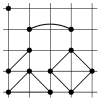Metastability of Synchronous and Asynchronous Dynamics
- PMID: 35455114
- PMCID: PMC9029560
- DOI: 10.3390/e24040450
Metastability of Synchronous and Asynchronous Dynamics
Abstract
Metastability is a ubiquitous phenomenon in nature, which interests several fields of natural sciences. Since metastability is a genuine non-equilibrium phenomenon, its description in the framework of thermodynamics and statistical mechanics has progressed slowly for a long time. Since the publication of the first seminal paper in which the metastable behavior of the mean field Curie-Weiss model was approached by means of stochastic techniques, this topic has been largely studied by the scientific community. Several papers and books have been published in which many different spin models were studied and different approaches were developed. In this review, we focus on the comparison between the metastable behavior of synchronous and asynchronous dynamics, namely, stochastic processes in discrete time in which, at each time, either all the spins or one single spin is updated. In particular, we discuss how two different stochastic implementations of the very same Hamiltonian give rise to different metastable behaviors.
Keywords: asynchronous dynamics; lattice spin systems; metastability; probabilistic cellular automata; synchronous dynamics.
Conflict of interest statement
The authors declare no conflict of interest.
Figures








Similar articles
-
Competitive nucleation in reversible probabilistic cellular automata.Phys Rev E Stat Nonlin Soft Matter Phys. 2008 Oct;78(4 Pt 1):040601. doi: 10.1103/PhysRevE.78.040601. Epub 2008 Oct 1. Phys Rev E Stat Nonlin Soft Matter Phys. 2008. PMID: 18999368
-
Synchronous and asynchronous updating in cellular automata.Biosystems. 1999 Sep;51(3):123-43. doi: 10.1016/s0303-2647(99)00025-8. Biosystems. 1999. PMID: 10530753
-
Dynamics of asynchronous random Boolean networks with asynchrony generated by stochastic processes.Biosystems. 2007 Mar;88(1-2):16-34. doi: 10.1016/j.biosystems.2006.04.002. Epub 2006 Jul 25. Biosystems. 2007. PMID: 16870321
-
Enhancing Metastability by Dissipation and Driving in an Asymmetric Bistable Quantum System.Entropy (Basel). 2018 Mar 26;20(4):226. doi: 10.3390/e20040226. Entropy (Basel). 2018. PMID: 33265317 Free PMC article. Review.
-
The labile brain. I. Neuronal transients and nonlinear coupling.Philos Trans R Soc Lond B Biol Sci. 2000 Feb 29;355(1394):215-36. doi: 10.1098/rstb.2000.0560. Philos Trans R Soc Lond B Biol Sci. 2000. PMID: 10724457 Free PMC article. Review.
References
-
- Penrose O., Lebowitz J. Fluctuation Phenomena. 2nd ed. North–Holland Physics Publishing; Amsterdam, The Netherlands: 1987. Molecular theory of metastability: An update. Appendix to the reprinted edition of the article “Towards a rigorous molecular theory of mtastability” by the same authors.
-
- Ruelle D. Statistical Mechanics: Rigorous Results. W.A. Benjamin; New York, NY, USA: 1965.
-
- van der Waals J. The equation of state for gases and liquids. Nobel Lect. Phys. 1910;1:254–265.
-
- Maxwell J.C. On the dynamical evidence of the molecular constitution of bodies. Nature. 1875;11:357–359. doi: 10.1038/011357a0. - DOI
-
- Maxwell J.C. In: Scientific Papers. Niven W.D., editor. Dover; New York, NY, USA: 1965.
Publication types
LinkOut - more resources
Full Text Sources

